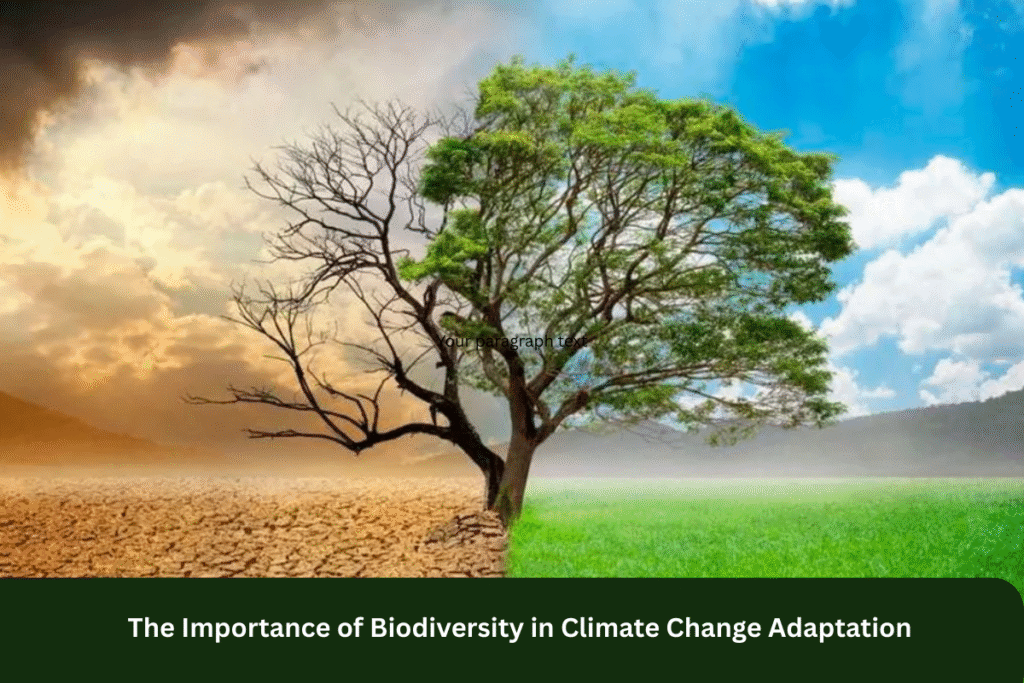
As the world continues to face the devastating effects of climate change, the importance of biodiversity in adaptation strategies cannot be overstated. Biodiversity—the variety of life on Earth—includes ecosystems, species, and genetic diversity, and plays a crucial role in maintaining the balance of our planet’s systems. The preservation and enhancement of biodiversity are essential to ensuring that ecosystems can adapt to climate change and continue to provide critical services like clean air, water, and food. This article explores the vital role biodiversity plays in climate change adaptation and how protecting it can help communities and ecosystems better respond to environmental challenges.
1. What is Biodiversity and Why Is It Important?
Biodiversity refers to the variety of life on Earth, encompassing all living organisms—plants, animals, fungi, and microorganisms—and the ecosystems they form. It also includes genetic diversity within species. Healthy ecosystems, supported by biodiversity, provide essential services that sustain life, such as:
- Pollination of crops: Bees, butterflies, and other insects help pollinate many of the crops we rely on for food.
- Water purification: Wetlands, forests, and other ecosystems naturally filter and purify water, ensuring clean drinking supplies.
- Soil fertility: A rich diversity of organisms, including worms and microbes, maintain soil health, supporting agriculture.
- Carbon sequestration: Forests, oceans, and other ecosystems absorb carbon dioxide, mitigating climate change.
Biodiversity is crucial for the resilience of ecosystems, helping them to adapt to changes, resist threats, and continue functioning effectively. As climate change accelerates, maintaining biodiversity is increasingly seen as a cornerstone of effective adaptation strategies.
2. How Biodiversity Contributes to Climate Change Adaptation
Climate change is affecting ecosystems worldwide, altering temperature, precipitation patterns, and the frequency of extreme weather events. Biodiversity plays a critical role in enabling ecosystems and species to adapt to these changes. Here’s how biodiversity contributes to climate change adaptation:
a. Enhancing Ecosystem Resilience
Biodiversity increases the resilience of ecosystems by allowing them to recover from disturbances like droughts, floods, and storms. Diverse ecosystems have a greater capacity to absorb shocks because different species respond to changes in different ways, ensuring that the ecosystem continues to function even if some species are affected.
For example, a diverse forest with multiple tree species is better able to withstand pests, diseases, and extreme weather than a monoculture forest. The variety of species ensures that if one species is weakened, others can take over and maintain the ecosystem’s health.
b. Supporting Ecosystem Services
Ecosystems that are rich in biodiversity provide a range of services that help communities adapt to climate change. These services include:
- Flood protection: Wetlands, mangroves, and coastal ecosystems act as buffers against storm surges and floods.
- Food security: Biodiverse farming systems are less vulnerable to pests and diseases, ensuring a stable food supply.
- Climate regulation: Forests, grasslands, and oceans capture carbon, helping to moderate climate extremes.
By conserving and restoring biodiversity, we can ensure that these ecosystem services continue to be available to support climate change adaptation.
c. Promoting Genetic Diversity for Resilience
Genetic diversity within species allows populations to adapt to changing environmental conditions, improving their chances of survival. For example, in agricultural systems, genetic diversity in crops and livestock can help them withstand climate stressors like drought, pests, and diseases.
In the wild, genetic diversity enables species to evolve and adapt over time, increasing their ability to cope with changing climates. Protecting this genetic diversity is critical for maintaining the adaptability of species in a rapidly changing world.
d. Facilitating Ecosystem-based Adaptation
Ecosystem-based adaptation (EbA) uses the services provided by biodiversity and ecosystems to help people adapt to climate change. For instance:
- Mangrove restoration: Mangrove forests provide coastal protection against rising sea levels and storm surges, helping communities adapt to coastal flooding.
- Agroforestry: Integrating trees into agricultural systems can enhance soil fertility, improve water retention, and provide shade, helping farmers adapt to changing rainfall patterns and temperature extremes.
By protecting and restoring ecosystems, EbA helps reduce the vulnerability of communities and ecosystems to climate change.
3. The Threats to Biodiversity in a Changing Climate
Climate change is a major driver of biodiversity loss, affecting species and ecosystems in a variety of ways:
- Temperature changes: Rising temperatures force species to migrate to cooler areas, disrupting ecosystems.
- Ocean acidification: The increase in CO2 in the atmosphere is also being absorbed by oceans, making them more acidic and threatening marine life.
- Habitat loss: Changing climates and extreme weather events destroy critical habitats, making it harder for species to survive.
- Altered migration patterns: Changing temperatures and seasons disrupt animal migration patterns, impacting species’ ability to reproduce and find food.
As biodiversity declines, ecosystems become more vulnerable to climate impacts, reducing their ability to support human populations and wildlife.
4. How Can We Protect Biodiversity for Climate Change Adaptation?
To harness the full potential of biodiversity in adapting to climate change, we need to focus on conservation and restoration efforts. Here are some ways to protect biodiversity:
- Conserving natural habitats: Protecting forests, wetlands, oceans, and other ecosystems ensures that they continue to provide critical services.
- Restoring degraded ecosystems: Restoration projects, such as reforesting areas or rebuilding coral reefs, can help bring back biodiversity and improve ecosystem resilience.
- Supporting sustainable land use: Practices such as sustainable farming, agroforestry, and responsible forestry can help preserve biodiversity while supporting livelihoods.
- Promoting biodiversity-friendly policies: Governments can implement policies that prioritize the conservation of biodiversity, such as establishing protected areas, supporting wildlife corridors, and regulating the use of natural resources.
5. FAQs
1. What is biodiversity?
2. How does biodiversity help in climate change adaptation?
3. Why is biodiversity important for food security?
4. What are some examples of ecosystem-based adaptation (EbA)?
Mangrove restoration to protect coastal communities from flooding and storm surges.
Agroforestry to improve soil health and water retention in agricultural systems.
Wetland conservation to regulate water flow and provide flood protection.
5. How does climate change threaten biodiversity?
6. Conclusion
Biodiversity is an essential component of climate change adaptation. Healthy ecosystems with rich biodiversity provide the resilience and services needed to help communities and species adapt to climate impacts. As climate change accelerates, protecting and restoring biodiversity should be a priority for both environmental and human well-being. By conserving natural habitats, promoting sustainable practices, and restoring ecosystems, we can ensure that biodiversity continues to play a pivotal role in helping our planet adapt to a changing climate.
